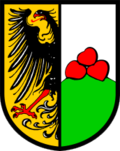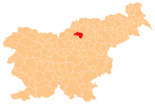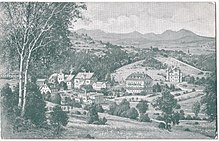Šoštanj
|
Šoštanj Schönstein |
|||
|
|||
| Basic data | |||
|---|---|---|---|
| Country |
|
||
| Historic region | Lower Styria / Štajerska | ||
| Statistical region | Savinjska (Sann area) | ||
| Coordinates | 46 ° 23 ' N , 15 ° 3' E | ||
| height | 367 m. i. J. | ||
| surface | 95.6 km² | ||
| Residents | 8,689 (2008) | ||
| Population density | 91 inhabitants per km² | ||
| Post Code | 3325 | ||
| License Plate | CE | ||
| Structure and administration | |||
| Mayor : | Darko Menih | ||
| Mailing address | Trg Svobode 12 3325 Šoštanj |
||
| Website | |||
Šoštanj (German: Schönstein ) is a town and municipality in the Spodnja Štajerska region ( Lower Styria ) in Slovenia .
8,689 people live in the total community, which consists of eleven localities. The main town of Šoštanj has 2793 inhabitants. The municipality is located in the western part of the Šaleška dolina.
Thermal water with a temperature of 32 ° C rises in the Topolšica district. The beginnings of this bath go back to the 16th century. There is also a lung hospital in the village. Topolšica was best known when General Alexander Löhr signed the surrender of the German army in Southeast Europe on May 9, 1945.
The lignite power station in Šoštanj has recently made headlines. It provides a third of Slovenia's electricity generation and was responsible for the large amount of particulate matter in recent years. A major renovation program has been reducing pollutant emissions for years.
etymology
The word Šoštanj comes from the German name of the city - Schönstein. The etymology of the German name can be seen on the coat of arms of the municipality. On the left side of the coat of arms is the Habsburg eagle, which represents the connection of the city to Austria and thus to the Habsburgs; the right side is a representation of the Old Castle of Šoštanj. The 'beautiful' castle (the symbol for it are the three red stone hearts) stood on a green hill. Today the castle is known under the name Pusti Grad (in German Empty Castle ).
geography
location
The town of Šoštanj is located in the Šalek valley ( Slovenian : Šaleška dolina , named after the Šalek / Schallegg castle in the east of the city of Velenje), an approximately eight km long and two km wide basin with the Paka ( Pack ) river. The state capital Ljubljana is located around 65 km southwest of the city.
Districts of the entire municipality
- Bele Vode , (German white water )
- Družmirje , (German Schmersdorf )
- Florjan , (German Saint Florian )
- Gaberke , (German Gaberg )
- Lokovica , (German Lokovitzen )
- Ravne , (German Gutenbichel )
- Skorno pri Šoštanju , (German Upper Skornau )
- Šentvid pri Zavodnju , ( Eng . Sankt Veit bei Schamberg )
- Šoštanj , (German Schönstein )
- Topolšica , (German Topolschitz )
- Zavodnje , ( Eng . Schamberg )
Neighboring communities
| Črna na Koroškem | Slovenj Gradec | Velenje |
| Ljubno |

|
Velenje |
| Mozirje | Mozirje | Šmartno ob Paki |
history
In the early antiquity the area of Šoštanj was part of the Noricum . After the kingdom was incorporated into the Roman Empire , the Romans built a road through the valley and perhaps even a post and military base called Upellae. The exact location of this building is unknown as the central area of the valley is now underwater due to coal mining. An old legend from the early Middle Ages says that the first settlers under the leadership of a prince named Tresimir founded the settlement of Družmirje. Today Družmirje is under water like Upellae. In Bele Vode ( Eng . Andrae-Katzenstein ) is the archaeologically important cave of Mornova Zijalka, which has now become a tourist spot. Srečko Brodar found stone tools and artefacts made of bronze and antique ceramic shards there in 1936.
In the western part of the Šaleška valley, the town of Šoštanj developed at the river deposit between the Paka and the 600 m high hills to the south. Šoštanj Castle is mentioned for the first time in 1200, Šoštanj as a marketplace first in documents from 1348. The town has developed from a hamlet to a marketplace in the safe environment around the old Šoštanj Castle over several generations. The old town castle, the administrative house, which was located on the edge of the market square, contributed to the development of the main square of Šoštanj. Important buildings from this period are the town hall with a small turret on the roof and the first building of the leather factory, which strongly shaped the history of the city. In the upper part of the market, the residents of Šoštanj erected a statue of St. Mary to protect the town from flooding. The old Šoštanj Castle still stood on a hill, but it was destroyed in the war between the Habsburgs and the Counts of Cilli . The official building, which was considered old in the 18th century, was also destroyed by fire. The noble lords who ruled in Šoštanj moved into the old manor house of Turn, which until then served as a granary for the whole town.
In 1635 there was a peasant uprising in Šoštanj , but it was quickly suppressed. In the 18th century an industry developed for the manufacture and processing of zinc and mercury . The mine was in operation until the First World War . In 1788 the Šoštanj leather factory was founded, one of the largest of its kind in Europe.
In 1911, Šoštanj was elevated to the status of a town by a decree by Emperor Franz Joseph I. With this decree, Šoštanj became the youngest German city in today's border area with Slovenia. During the war, the city was an important center of the military industry of Cisleithanien , because the leather factory was an important part of the soldiers' equipment, such as B. belts, military boots and other leather products. After the war, in the age of Interbellums did the Slowenisierung of Šoštanj. At that time, the public prosecutor Fran Mayer was mayor, who made the construction of the sewerage possible. Until the end of the German occupation of Lower Styria, Šoštanj was one of the most important industrial centers. Until the Second World War , Šoštanj was the center of the Šalek Valley. With the development of Velenje after the war and because of the socialist regime that saw the town of Šoštanj as a civil parish, Šoštanj lost its place as an independent municipality and was part of the municipality of Velenje until 1991 . After that the town continued to develop, but for financial reasons the Vošnjak leather factory, the largest and one of the oldest such factories in Slovenia, had to be closed. Today the lignite power plant in Šoštanj is the most important company.
Culture
| Country | Belonging to the administrative unit |
from ... to |
|---|---|---|
|
|
||
| Margraviate of Styria | 1164-1180 | |
| Duchy of Styria (from 1282 Habsburg , 1379 / 1411–1457 and 1564–1619 Inner Austria ) |
1180-1804 | |
|
|
Duchy of Styria | 1804-1867 |
|
|
Duchy of Styria ( Cisleithanien ) |
1867-1918 |
|
|
||
| Slovenia Province | 1918-1922 | |
| Maribor Oblast | 1922-1929 | |
| Drava Banschaft | 1929-1941 | |
|
|
CdZ area Lower Styria | 1941-1945 |
|
|
||
| People's Republic of Slovenia - Municipality of Šoštanj | 1945–1963 | |
| Socialist. Rep. Slovenia - Municipality of Velenje | 1963-1990 | |
| Republic of Slovenia - Municipality of Šoštanj | 1990-1991 | |
|
|
Municipality of Šoštanj | since 1991 |
Theaters and cultural institutions
- Culture house
- City Gallery
- Museum of Leather Manufacture (Slovenian Muzej usnjarstva na Slovenskem , since 2009)
- Villa Mayer
Sports
- Mountaineering Society Šoštanj
- Elektra basketball club
- Šoštanj volleyball club
- General sports club Šoštanj
music
- Zarja Šoštanj wind orchestra
- Mixed choir Svoboda Šoštanj
Regular events
- Mardi Gras Parade Šoštanj
- Annual hiking on the historic hiking trail around Šoštanj
Other bodies
- Bridge Club of the Šalekta Valley
- Local community Šoštanj (Krajevna skupnost Šoštanj)
- City magazine Šoštanjski List
Economy, infrastructure and education
- Thermoelectric power plant Šoštanj
- Šoštanj is connected to the next largest city of Celje by the Celje – Šoštanj railway, an extension of the Slovene Lavant Valley Railway from Dravograd, which was partly shut down after the Second World War.
- Primary school Šoštanj - the largest primary school in Slovenia with more than 800 students.
- Music school “Fran Korun Koželski” Šoštanj
Attractions
Kavčnik's farm
Kavčnik's farm is a valuable monument of Slovenian rural living culture. It is in Zavodnje nad Šoštanjem. It is the southernmost smoke chamber in the Alpine region. Smoking chambers were common here between the 11th and 18th centuries. Because fires often broke out in the smoke chambers, they were replaced by smoke kitchens (also because of state regulations). The building was built in the 17th century. The smoke chamber was built as the first room. Other parts of the building were later added. The cellar, the stable in the basement and the smoke room are bricked; the remaining parts of the building are made of wood. The roof is covered with shingles. The last inhabitant was engaged in herbal medicine and there is still an herb garden next to the house. The farm was inhabited until 1981. All of the original equipment is still preserved today, and its arrangement gives the impression that the farm is still inhabited.
Parish churches
The parish church in the city is dedicated to the Archangel Michael and belongs to the Roman Catholic diocese of Celje. A second church in the city was built in 1776 on the site of a previous 13th century church and is dedicated to Saints Hermagoras and Fortunatus . The current building was built in the second half of the 18th century. All that remains of the original building is the bell tower, which contains a fresco.
Pusti degree
A popular lookout point, Šoštanj Castle, is one of the features that characterize today's town of Šoštanj. After the castle was destroyed in the 15th century, it still remained as one of the symbols of the municipality and the city. Today there is only one defensive tower of the old castle. Because of the castle's deposit, the ruins are a popular photo opportunity. Originally it was called Schenstein Castle , today it is known as Pusti Grad (in German Empty Castle ).
Gutenbichel Castle
In Ravne ( Eng . Gutenbichel ), northwest of the town of Šoštanj itself, is the manor house of Gutenbichel (also called Gutenpihl , Guetenbicl and Guetenbichel ). The first building was built in the 16th century, and in its long history Gutenbichl Castle had many owners from German and Wendish noble families. The most important of them were the last - the industrial Vošnjak family (in some documents you can also find the German version of the name - Woschnagg ). In 1931 the Vošnjak family completely renovated the building. The park in front of the castle was particularly famous. After the Second World War, many buildings across Slovenia were nationalized and the Vošnjaks lost the castle. Until 2006, the building was a branch facility of the Vojnik Psychiatric Hospital.
Slovenian Leather Manufacturing Museum
Leather production has traditionally been an important industry in Slovenia for centuries. With industrialization, this trade grew partly to an industrial level and was an important economic sector in the 20th century. In the crisis of leather production in the second half of the 20th century, most industrial companies went under. The Museum of Leather Production in Šoštanj presents a chronological overview of the 210-year tradition of leather production, from the foundation of Vošnjak's leather factory in 1788 to the rise of large-scale industry and the closure of the factory in 1999. The exhibition emphasizes the importance of the Vošnjak family and the influence of the factory on the economic development of Šoštanj, where the smell of leather shaped the town. The second part of the exhibition shows the workers' apartment, the manager's office, Lujek's shoemaker's workshop and excerpts from the life and fate of Vošnjak's industrialists. The activities of the associations represent the cultural and social life of the inhabitants of Šoštanj and the everyday life of a worker and his family.
Topolšica thermal baths
The power of thermal water attracted visitors to the Toplice Valley as early as the 16th century. The thermal baths known as Florian Heilbad were opened to the public in 1838, but the thermal spring was not set up for medicinal purposes until six decades later. At that time, the first buildings for seasonal guests were built. At the turn of the century, the professionally managed physical and dietetic spa began its activity in Topolšica. Josip Vošnjak described the eventful life in Topolšica as follows in his memoir »Spomini« (1905):
“Even an ordinary visitor can no longer bathe for 3 cruisers. The former idyll with simple farmer's food for people with strong senses had to give way to the modern spa for modern neurasthenics. Here, men and women saturated with city life run around barefoot on the sandy paths, let themselves be roasted in the sun's rays and sleep in open huts in order to put their tattered senses in order at least for the time until the next season. "
In the 1980s, a modern spa tourism complex with a high-quality hotel and catering offer as well as numerous activities in the field of recreational sports and other accompanying activities grew up on the basis of the spa tradition. The Topolšica thermal baths are adorned with an enviable tradition of healing and medicine, the latest modernizations have transformed the thermal bath into a splendid thermal tourism complex.
Villa Mayer
The lawyer Fran Mayer (1866–1940), for Šoštanj an important and influential public figure, had the Villa Mayer built after him in 1897. The villa was built as a residential property with an associated law firm and park. The garden with the park was laid out in the English style before the Second World War, in which it was quite badly damaged, in the 1970s its size was reduced by a quarter with the construction of the school gym. The municipality of Šoštanj has declared the villa with the garden a cultural monument of local importance (EŠD 16635) on the basis of the technical principles of the Institute for the Protection of the Cultural Heritage of Slovenia, Celje Regional Unit. In 2007 the institute prepared the conservation program for the renovation of the villa and the garden, which began in May 2009.
The permanent collections in Villa Mayer are the sculptor collections of the academic sculptor, the farmer Ivan Napotnik, a selection of pictures from the collection of the Napotnik gallery, part of the private collection of the local history collection of Zvone A. Čebul and the horticultural collection of the gardener Alojz Kojc.
Personalities
- Karel Destovnik , aka Kajuh, partisan and poet
- Jožef Kastelic, religious writer
- Viktor Kojc, Slovenian botanist
- Jože Lambret, Slovenian priest and partisan fighter
- Dušan Mayer, Austrian officer; fallen in 1917
- Fran Mayer, lawyer and mayor
- Peter Musi, librarian and founder of the library
- Ivan Napotnik, Slovenian sculptor
- Ivan Röck - Biba, partisan
- Ivan Samonigg, Austrian officer and military education reformer
- Eberhart Šoštanjski, nobleman from the 12th century
- Herman Šoštanjski, nobleman from the 12th century
- Mihael Valenci, technical writer and doctor
- Hans Woschnagg, Slovenian civil servant during the time of the Austro-Hungarian monarchy
- Josip Vosnjak, national leader of the 19th century liberals
- Mihael Vosnjak, engineer and politician
Town twinning
-
 Tešanj (Bosnia)
Tešanj (Bosnia)
Web links
Individual evidence
- ↑ Surrender ( memento of October 11, 2006 in the Internet Archive ). Accessed August 1, 2009
- ^ Story of Šoštanj ( Memento from February 17, 2018 in the Internet Archive ) Accessed February 16, 2018
- ↑ see the museum's website, in Slovenian
- ↑ Kavčnik's farm ( memento from June 23, 2015 in the Internet Archive ). Accessed February 15, 2018
- ↑ Parish Church of St. Mohor and Fortunatus ( Memento from June 29, 2007 in the Internet Archive ). Accessed February 16, 2018
- ↑ Reference number ešd 3436 ( Memento from December 26, 2009 in the Internet Archive ). Accessed February 15, 2018
- ^ Pusti Grad ( Memento of April 24, 2012 in the Internet Archive ) Accessed on February 16, 2018
- ↑ Gutenbichel ( Memento of October 29, 2007 in the Internet Archive ) Accessed on February 16, 2018
- ^ Coal Mining Museum ( Memento from June 23, 2015 in the Internet Archive ) Accessed February 15, 2018
- ↑ Topolšica ( Memento from January 27, 2016 in the Internet Archive ) Accessed February 15, 2018.
- ↑ Villa Mayer ( Memento from July 6, 2016 in the Internet Archive ). Accessed February 16, 2018.










